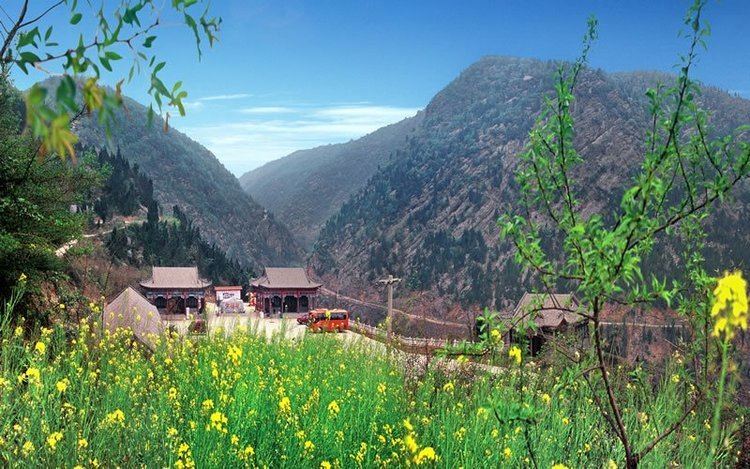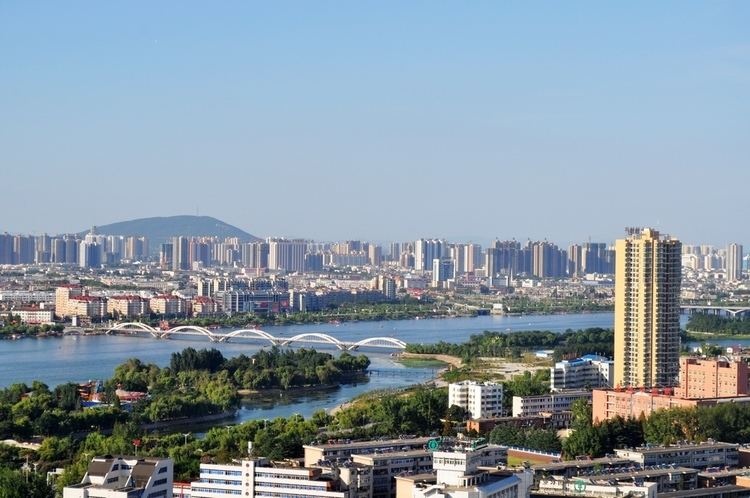Mayor Huang Xingwei | Area 26,508.69 km2 | |
 | ||
Country Peoples Republic of China University Nanyang Normal University | ||
Map of Nanyang, Henan
Nanyang (simplified Chinese: 南阳; traditional Chinese: 南陽; pinyin: Nányáng) is a prefecture-level city in the southwest of Henan province, China. The city with the largest administrative area in Henan, Nanyang borders Xinyang to the southeast, Zhumadian to the east, Pingdingshan to the northeast, Luoyang to the north, Sanmenxia to the northwest, the province of Shaanxi to the west, and the province of Hubei to the south.
Contents
- Map of Nanyang Henan
- Rubbish van plays christmas songs in nanyang henan china
- Chinese noodlelamb noodle souphenan food
- Names
- Geography
- Climate
- Administration
- Railways
- Roads and expressways
- Airport and airlines
- Public transit
- Demographics
- Culture
- Famous people from Nanyang
- Temples cathedrals and mosques
- Sights
- Shopping
- Hotels and lodging
- Nightlife
- Economy
- References

It had 10,263,660 inhabitants at the 2010 census, ranking eleventh in China. However, 1,811,812 residents live in the built-up area made of two urban districts (Wolong and Wancheng). Dinosaur egg fossils have been discovered in the Nanyang Basin.

The 35,000 capacity Nanyang Sports Centre Stadium is the main (football) venue in the city.
Rubbish van plays christmas songs in nanyang henan china
Chinese noodlelamb noodle souphenan food
Names
Nanyang (simplified Chinese: 南阳; traditional Chinese: 南陽; pinyin: Nányáng) 南-South, 阳/陽-sun (the south side of a mountain, or the north side of a river, which in Chinese is called Yang meaning "sunny"). Wan (宛) is the abbreviation for Nanyang which in ancient times was known as Wancheng (宛城), meaning "Wan City".
Geography
Nanyang is located in southwestern Henan, bordering Hubei (Xiangyang, Shiyan, and Suizhou) to the south, Shaanxi (Shangluo) to the west and the following prefecture-level cities in Henan:
The latitude of the entire prefecture ranges from 32° 17' to 33° 48' N, while the longitude ranges from 110° 58' to 113° 49' E, and the prefecture spans 26,600 square kilometres (10,300 sq mi). The city lies within the Nanyang Basin, which is part of a region in Central China that lies in the gap between the eastern end of the Qin Mountains and the source of the Huai River. Thus, using those two geographic features as the standard dividing line, it is difficult to classify the city into northern or southern China.
To the north of Nanyang city proper, there is a mountain called Mount Du, which is famous for the Dushan jade, one of the four famous jades of China, now a rarity. To the southwest is Neixiang County with the newly developing Baotianman Biosphere Reserve—an area of high biodiversity, with 65 rare and endangered species.
Climate
The climate is generally moderate and is a four-season humid subtropical climate (Köppen Cwa), with strong monsoon influences: winters are cool but dry, and summers are hot and humid. Spring and autumn provide transitions of reasonable length. The monthly daily average temperature in January is 1.4 °C (34.5 °F) and in July it is 26.9 °C (80.4 °F); the annual mean is 14.9 °C (58.8 °F). More than half the annual rainfall occurs from June to August.
Administration
The prefecture-level city of Nanyang administers 2 districts, 1 county-level city and 10 counties.
Railways
Nanyang has one major railway station: Nanyang Railway Station. There are also several other small stations serving suburban areas.
Nanyang is a railway junction for the Nanjing-Xi'an Railway and the Jiaozuo-Liuzhou Railway. Direct train service is available to Shanghai, Nanjing, and Hefei to the east, Xian and Lanzhou to the west, Luoyang to the north and Liuzhou to the south.
Roads and expressways
Over 500 km (310 mi) of highway network has been built along the railway line and others. An 80 km (50 mi) beltway is being constructed surrounding the city. As of 2009, feasibility studies for 80 km of elevated rope suspension pathways hanging 10 meters high for pedestrian and bicycle use have been approved by city level governance. Installation will begin early 2010.
Airport and airlines
Nanyang Airport is one of three civil aviation airports in the province. It is only 20 minutes bus time from the urban area. Passengers can take flights to and from Beijing, Shanghai, Guangzhou, Shenzhen, and Guilin.
There are also two avion airports.
Public transit
Nanyang city buses have about 30 lines in the urban area. Taxis are common.
Demographics
The whole city area has a population over 10.26 million, which is the twelfth prefecture-level city in China now. The built-up area has over 1.8 million people, which is the fifth largest city in Henan Province. About 1 million commute from the city, mainly to Zhengzhou, Guangdong province, Beijing and Shanghai. The majority of the province is Han; among the minority nationalities are the Hui people and Man people.
Culture
The official language of Nanyang is Mandarin Chinese, but most locals speak the Henan dialect, with its easily identifiable stereotypical features; this local dialect is known as Nanyang Hua (南阳话), and is spoken by about 15 million people in the area.
There is also a local form of Chinese opera called Wan Opera.
